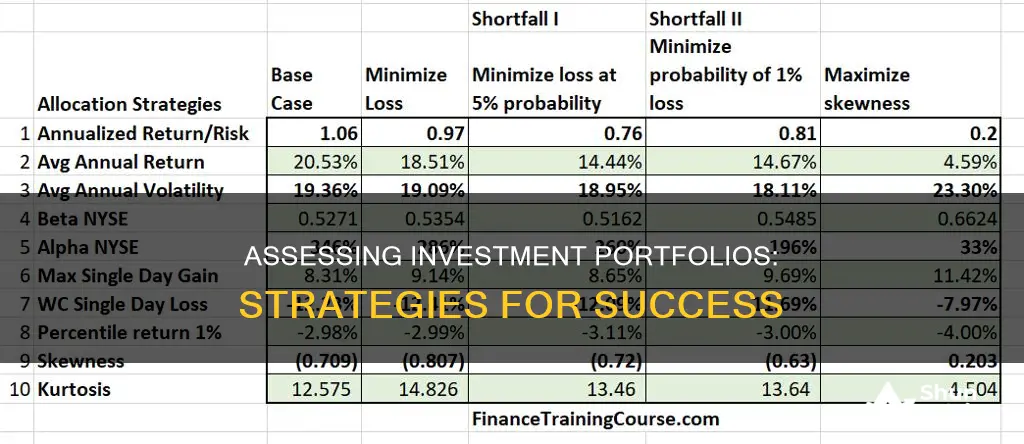
Evaluating an investment portfolio is a critical aspect of managing and monitoring your assets. It involves tracking the performance of your investments and making necessary adjustments to stay on course toward your financial goals. This process includes assessing the returns and risk associated with your investments. By using tools like Personal Capital and Morningstar, you can effectively monitor your portfolio's performance, investment fees, asset allocation, and progress toward your financial objectives. Additionally, understanding key performance measures such as yield, rate of return, and risk-adjusted returns is essential for making informed decisions. Ultimately, the goal of portfolio evaluation is to build a robust portfolio that aligns with your short-term, medium-term, and long-term financial aspirations.
| Characteristics | Values |
|---|---|
| Track portfolio performance | Compare each investment's returns with other schemes in the same category |
| Check portfolio allocation | A diverse portfolio with a mix of stocks, mutual funds, ETFs, gold, and p2p lending |
| Identify fees | Investment fees can eat into profits; lower fees are better |
| Assess goals | Goal-based investing gives a clear idea of what should be kept or sold from the portfolio |
| Monitor performance | Monitor investments annually, or quarterly |
| Evaluate risk | Use statistical risk methods such as Standard Deviation, Beta, R-Squared, Sharpe Ratio, Jensen Ratio, and Sortino Ratio |
| Compare returns | Compare returns over several years to see how investments behave in different market environments |
| Rebalance | Make adjustments when the situation calls for it |
What You'll Learn

Track portfolio performance
Tracking portfolio performance is a critical aspect of managing and monitoring your investments over time. Here are some detailed steps and strategies to effectively track your portfolio's performance:
Determine the Performance Metrics
The first step in tracking portfolio performance is to decide on the specific metrics you will use to evaluate your investments. The most common metric is the total return, which measures the overall returns of an investment or portfolio. This includes any income or gains generated by the investment over a specific period. When calculating total return, it's important to consider factors such as transaction fees, taxes, and inflation, as they can impact your overall returns.
In addition to total return, it is crucial to consider risk measures as well. Standard deviation, beta, R-squared, and Sharpe ratio are some commonly used statistical measures to evaluate the volatility and risk associated with your investments.
Choose a Monitoring Time Horizon
The choice of time horizon depends on your investment goals and style. For long-term goals like retirement planning, investors often focus on 5-year and 10-year returns, while also considering shorter periods. The most common unit of measurement for monitoring investment performance is one year, and for longer periods, returns are "annualized" to calculate an annual average.
Select a Performance Benchmark
The choice of performance benchmark depends on the types of investments in your portfolio. For stocks, the primary benchmark is often the S&P 500 index, while for bonds, it might be the Barclays US Aggregate Bond index. You can also use multiple benchmarks or a balanced index fund that aligns with your asset allocation.
Monitor Performance Regularly
Regular monitoring of your portfolio's performance is essential. A yearly evaluation, at roughly the same time each year, can help keep you engaged and informed about your investments' progress. Depending on the nature of your investments, you may receive consolidated statements from your financial services firm, or you may need to review multiple statements to get a comprehensive view of your portfolio's performance.
Additionally, many firms provide online access or phone services to check the latest values of your holdings. You can also utilise investment tracking software or tools like Personal Capital and Morningstar, which offer free financial dashboards and portfolio trackers to help you monitor performance more efficiently.
Compare Returns and Make Adjustments
By comparing your returns over several years, you can identify patterns and see how your investments perform in different market environments. This information can guide you in making adjustments to your portfolio as needed. Remember that effective performance evaluation involves finding a balance between taking a "set it and forget it" approach and incessant monitoring.
In summary, tracking portfolio performance involves measuring returns, evaluating risk, selecting appropriate benchmarks, and regularly monitoring your investments' progress. By following these steps, you can make more informed decisions about your portfolio and work towards achieving your financial goals.
Invest Your Savings Wisely: A Guide for Nigerians
You may want to see also

Check portfolio allocation
Checking your portfolio allocation is a critical step in evaluating your investments. It involves reviewing the distribution of your investments across different asset classes, sectors, and individual securities. The first step is to understand your current allocation and whether it aligns with your investment goals and risk tolerance. You can do this by calculating the weight of each asset class in your portfolio, such as stocks, bonds, cash, and alternative investments. For example, if you have $100,000 invested and $60,000 is in stocks, your stock allocation is 60%.
Once you have a clear picture of your current allocation, you can evaluate whether it meets your investment objectives. Diversification is a key principle here. A well-diversified portfolio typically reduces risk by spreading investments across various asset classes and industries. Check if your portfolio is adequately diversified and if any adjustments are needed to align with your target allocation. For instance, if your portfolio heavily favors one particular stock or sector, you may want to consider rebalancing to reduce the concentration risk.
Additionally, review your portfolio's allocation in the context of your risk tolerance and time horizon. If you have a longer investment timeframe, you may opt for a more aggressive allocation with a higher proportion of stocks. Conversely, if you are risk-averse or nearing retirement, a more conservative allocation with a greater focus on income-generating assets and capital preservation may be appropriate. It's essential to ensure that your portfolio allocation matches your comfort level with risk and aligns with your long-term financial goals.
Finally, monitoring your portfolio allocation over time is crucial. Regularly review and rebalance your portfolio to maintain your desired allocation. Market movements can cause your portfolio to drift from its original allocation, leading to unintended risk exposure. By periodically rebalancing, you buy and sell assets to return your portfolio to its target weights. This disciplined approach helps control risk, ensuring that your portfolio stays aligned with your investment strategy and objectives.
Building a Wine Investment Portfolio: A Beginner's Guide
You may want to see also

Identify fees
When evaluating an investment portfolio, it is important to identify the fees you are paying. Investment fees can eat into your profits, so it is generally best to opt for lower fees.
There are various types of investment fees to look out for. Transaction fees are incurred when you buy or sell an investment. These can add up, so it is important to factor them into your calculations when assessing the performance of your investments. If you are calculating the return on actual gains or losses after selling an investment, be sure to subtract the fees you paid when you sold.
Additionally, consider the role of taxes on performance. It is often helpful to compute after-tax returns with the help of a tax professional. Inflation may also play a significant role in calculating your return for long-term investments, as your money loses value over time.
It is also worth noting that some investment tracking tools can calculate your fees across your entire portfolio and show you how those fees will affect your returns over time.
Building an Investment Portfolio: A Comprehensive Guide
You may want to see also

Assess goals
Setting investment goals is a crucial step in building a robust investment portfolio. Here are some detailed and direct instructions to help you assess your investment goals effectively:
Identify Your Financial Goals
Start by identifying your short-term, medium-term, and long-term financial goals. Short-term goals may include saving for a new car, a wedding, or a master's degree, while medium-term goals could be saving for a house down payment or your children's education. Long-term goals typically involve retirement planning. Clearly defining your financial goals is essential for effective portfolio management.
Determine Your Risk Tolerance
Different investments come with varying levels of risk. It's important to assess your risk tolerance, which refers to the amount of risk you're comfortable taking on in pursuit of your financial goals. A trained financial advisor can help you assess your risk tolerance and make suitable investment recommendations.
Understand the Types of Investments
Educate yourself about the various types of investments available, such as stocks, mutual funds, exchange-traded funds (ETFs), bonds, and gold. Each investment type carries different levels of risk and potential returns. For example, stocks typically offer higher potential returns but come with higher risk, while bonds are generally considered lower-risk but yield lower returns.
Diversify Your Portfolio
Diversification is a key strategy in investment portfolio management. By spreading your investments across various asset classes, sectors, and industries, you can potentially reduce risk while maximizing returns. A well-diversified portfolio may include a mix of stocks, mutual funds, ETFs, and other investment options.
Seek Expert Advice
Consider consulting a financial advisor or wealth coach to review your investment goals and provide personalized recommendations. They can help you allocate your portfolio in a way that aligns with your goals and risk tolerance. Additionally, they can provide valuable insights into different investment options and strategies.
Regularly Review and Rebalance
Investment goals can change over time, and it's important to stay adaptable. Regularly review your investment portfolio to ensure it still aligns with your financial goals and risk tolerance. If necessary, rebalance your portfolio by adjusting your asset allocation to maintain your desired level of risk and financial objectives.
Remember, assessing your investment goals is an ongoing process that requires regular attention and adjustments. By following these steps and working with financial professionals, you can make more informed decisions about your investment portfolio to help you achieve your financial aspirations.
Creating Investment Portfolio Projections: A Comprehensive Guide
You may want to see also

Measure risk
Measuring the risk of your investment portfolio is a crucial aspect of evaluation. Here are some detailed instructions and considerations to help you measure the risk involved:
Diversification
A well-diversified portfolio can help reduce risk. This involves spreading your investments across various asset classes, such as stocks, mutual funds, ETFs, gold, and p2p lending. Diversification ensures that your portfolio is not overly exposed to the risks associated with any single investment or asset class.
Risk Measures
There are several statistical risk measures you can use to assess the volatility of your portfolio:
- Standard Deviation: This measures the volatility of an investment or portfolio. A higher standard deviation indicates greater price variation and higher volatility.
- Beta: Beta is a statistical measure that compares the risk of an investment to a market benchmark. A beta of 1.0 indicates the same level of volatility as the market. A beta higher than 1.0 means the investment is more volatile than the market, while a lower beta indicates lower volatility.
- R-squared: This statistical measure represents the percentage of an investment's price movements that correlate with its benchmark index. For example, an R-squared of 0.95 means that 95% of the investment's price changes are linked to its benchmark.
Risk-Adjusted Returns
It's important to evaluate risk-adjusted returns, as they provide a more comprehensive view of your portfolio's performance. Here are some popular ratios that incorporate risk and return:
- Treynor Ratio: This measures the portfolio's return per unit of risk. It considers both the portfolio's return and its sensitivity to the overall market's movements (beta).
- Sharpe Ratio: This ratio is similar to the Treynor measure but uses the standard deviation of the portfolio as the risk measure. It evaluates both the rate of return and diversification.
- Jensen Ratio: This measures the excess return generated by a portfolio over its expected return, adjusted for market risk.
Monitoring Frequency
When measuring risk, it's important to choose an appropriate monitoring frequency. A common choice is quarterly (every three months), as investment data is often reported on a quarterly basis. Regular monitoring helps you stay informed and make adjustments if needed.
In conclusion, measuring risk is a critical aspect of evaluating your investment portfolio. By considering diversification, using appropriate risk measures, evaluating risk-adjusted returns, and monitoring your portfolio's performance regularly, you can make more informed decisions and work towards achieving your financial goals.
Reviewing Your Investment Portfolio: How Often is Necessary?
You may want to see also
Frequently asked questions
It is recommended to evaluate your portfolio at least once a year to keep track of your investments and adjust where necessary.
Some key metrics include total return, yield, rate of return, standard deviation, beta, R-squared, Sharpe ratio, and Sortino ratio.
Evaluating your investment portfolio helps you understand if you are gaining profits or losing money and allows you to make adjustments to stay on track with your financial goals.







